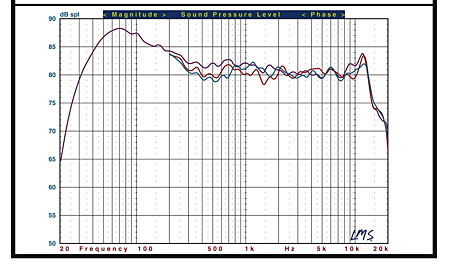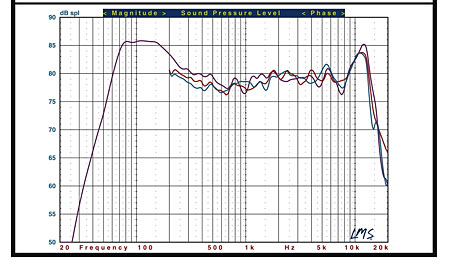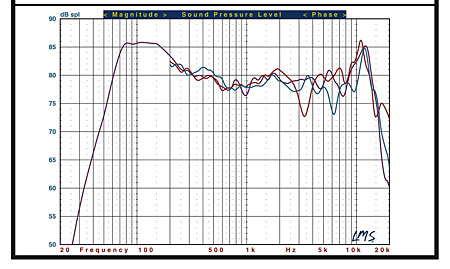mbl Radialstrahler 116/121/111RC 5 Channel Surround Sound System Measurements
All measurements shown were taken with the grilles removed. The impact of the grilles on the frequency response plots of both speakers is measurable and visible, but should be audibly negligible. The impedance of the mbl Radialstrahler 116 dropped to minimums of 6.6Ω at 128Hz and 4.8Ω at 11kHz. The bass impedance is exceptionally linear, making it difficult to determine the cabinet tuning from that measurement. But judging by the maximum port output the cabinet appears to be tuned to approximately 28Hz.
I would rate the speaker's nominal impedance at 9Ω. The impedance phase angle is also remarkably benign across the entire frequency range, and together with its magnitude (which is higher than specified and thus less of a drain on an amplifier's current-delivery capability) the impedance of the 116 should be no challenge for any competent amplifier.
The same may not be true of the 116's sensitivity. It measured around 82dB/2.83V/m (very close to specification), making that easy-to-drive impedance even more important than it would be in most speakers. Compared to a more typical speaker sensitivity of 88dB/2.83V/m, the 116 will require 4 times the power to achieve the same sound levels (each 3dB reduction in sensitivity results in a doubling of the power needed for the same output). Michael Fremer is not joking when he recommends as much power as you can muster to drive the mbls—though he was able to achieve satisfying results with much less than some listeners might consider ideal.
The horizontal averaged front response of the 116 is shown in Fig.1 (violet). This is the pseudo-anechoic response averaged over a 30° forward horizontal angle, taken at tweeter height, combined with the nearfield responses of the woofers and port.

Fig.1: mbl 116, pseudo-anechoic response, off-center in the horizontal plane, at 45° (red) and 60° (blue).
The 116's response, taken in this manner, is superb across the vital range from 300Hz to about 8kHz. The bottom end measurement shows an effective lower limit of 28Hz (-10dB relative to the output at 100Hz).
But there is also a significant bump-up in the mid-upper bass, centered at about 70Hz. This characteristic can sometimes be due to our near-field, low frequency measurement technique. But we use the same procedure for all of our speaker measurements and don't always see this characteristic. In any case, given a similar room and setup you can expect that the mbl will be considerably warmer-sounding than a speaker that measures relatively flat in this region—for example, the Revel Ultima2 Studio2.
The 116's top end suggests a lower than typical tweeter resonance, with a moderate peak at around 11kHz and a response that falls off rapidly above this point.
The effect of this seeming lack of very high frequencies, however, may be at least partially offset by the tweeter's superbly uniform response pattern. If you've been following our measurements of other speakers, you won't recall any whose response is as consistent—and consistently good across most of the audible range both on and off-axis—as the mbl 116's. It is as close to identical at all our measured horizontal angles as any real-world speaker is ever likely to be.
Vertically (Fig.2), you're slightly better off sitting a bit below the tweeter than above it. But even slightly above the tweeter (an unlikely spot given the speaker's height) the differences, apart from a suckout just above 3kHz and slightly more treble energy, are less than we usually see.

Fig.2: mbl 116, pseudo-anechoic response at 15° above (red) and 15° below (blue) the tweeter axis.
The mbl 111RC's minimum impedance measured 4.5Ω at 10.5kHz and 5.9Ω at 69Hz. I would rate the nominal impedance at 8Ω. The impedance phase angle is largely benign, but does become highly capacitive at very low frequencies. This should not be an issue if the speaker is used as a center or surround and high-pass filtered somewhere at or around 80Hz.
The mbl 111RC's sensitivity measured approximately 79dB/2.83V/m—lower than specified and lower than the sensitivity of the mbl 116 as well. While the 111RC should be an easy load to drive as far as its impedance characteristics are concerned, as with the 116 its low sensitivity strongly suggests the use of a potent power amplifier for best results.
The measured front horizontal response of the 111RC, taken on the tweeter axis and averaged in the same manner as described above for the 116, is shown in Fig.3 (violet curve). The system is tuned to approximately 74Hz and the response rolls off rapidly below that point, with an effective bass limit of approximately 54Hz (-10dB relative to the output at 100Hz).

Fig.3: mbl 111RC, pseudo-anechoic response, off-center in the horizontal plane, at 45° (red) and 60° (blue).
The frequency response linearity of the 111RC is also excellent across most of the frequency range, with superbly even dispersion. There is also no sign of off-axis suckouts; within limits determined by the room and setup, the response should be consistent at any listening angle. As in the mbl 116, however, there is a significant rise in the 111's measured response in the mid-high bass region. It also has the same high frequency peak and rapid rolloff above it. This HF peak is also a bit more pronounced than with the 116. But since the same tweeter is used in both speakers, these small measured differences may be attributable to unit-to-unit sample variations.
Fig.4 shows the vertical response of the 111RC at + 15° (red) and –15° (blue), overlaid again with the averaged front horizontal response. There is a bit more response unevenness at high and low vertical angles than in the 116. But MF sat well below the tweeter axis and did not find the response variations audibly significant. Apart from the measured rises in the response at the bottom and top of the frequency range, the mbls turned in an impressive set of test bench results.

Fig.4: mbl 111RC, pseudo-anechoic response at 15° above (red) and 15° below (blue) the tweeter axis.
Thomas J. Norton
All figures: Violet curve: pseudo-anechoic response on the tweeter axis, averaged across a 30° horizontal window, combined with nearfield responses of the woofers and port. All measurements taken at 1 meter.
- Log in or register to post comments



























































